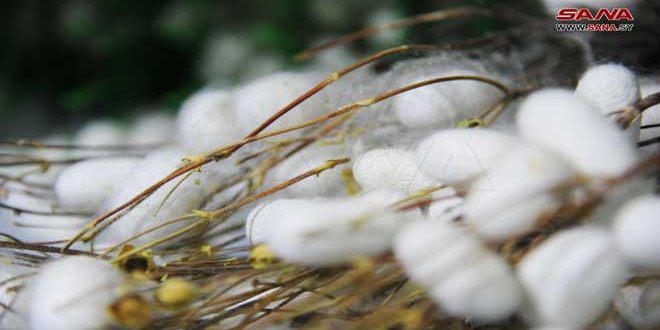Damascus-SANA
The textile industry in general and silk in particular is one of the traditional industries in Syria known throughout history. To protect the craft of the silk industry in it, the Ministry of Agriculture launched in 2016 a national project to revive silkworm breeding, during the period between 2017 and 2026, to be carried out in three stages.
Dr. Iyad Muhammad, Director of Plant Protection at the Ministry of Agriculture and Agrarian Reform, explained to SANA reporter that the ministry is currently following the selection process to obtain silkworm eggs and breeding worms until the third larval age, to be distributed to breeders for free, as well as supervising the breeding process and securing mulberry seedlings and planting them in forested sites. Close to breeders, indicating that work is being done to secure automatic and manual equipment to help breeders unravel their cocoons, import silkworm eggs, and implement training courses for breeders and technicians interested in silk, in addition to granting a reward of 2,000 pounds for each kilo of cocoons produced.
Muhammad said: The process of silk production “inputs and outputs” is reduced according to the following equation, a tray of eggs consisting of 13 grams, in addition to a place for breeding with an area of 20 cubic meters and 600 kilograms of mulberry leaves, to give 35 kilograms of silk cocoons, and thus 4.5 kilograms of silk. Pointing out that the process of silkworm breeding and silk production goes through several stages and procedures, starting with the provision of a breeding room, securing and hatching egg boxes, breeding and nesting worms, and ending with the cocoon stage and ending with the thread-dissolving stage.
Muhammad concluded his speech with several points that expressed the ministry's aspirations according to its capabilities to develop prospects for silkworm breeding, such as participating in local and foreign exhibitions and coordinating with interested international organizations, with the aim of re-importing eggs, increasing the number of mulberry seedlings, spreading their cultivation in breeding areas, activating silkworm breeding in development villages, and displaying products in Outlets selling rural women’s products spread across the Syrian governorates under the name of the Syrian Silk Corner.
With regard to silkworm breeding, Dr. Eng. Hisham Al-Zer, a faculty member at the University of Damascus and a member of the Silk Committee at the International Silk Center Lyon in France, explained that it has an economic importance, as a carton of imported eggs weighs 10.7 grams and contains about 20,000 eggs, giving between 35 and 45 kilograms of cocoons. The price of a kilo of cocoons is 25,000 pounds, which confirms that it is profitable farming, especially since the breeding season for one lug extends for about a month, and the product of its waste is used as fertilizer and does not need fermentation, and the virgin ones are considered bait for fish, in addition to providing them with many job opportunities during the season, with few efforts and expenses. .
He added: Work is being done through the University of Damascus and its existing laboratories, such as the laboratory of bees and silk, in cooperation with breeders, the Ministry of Agriculture, the Directorate of Agricultural Research, and relevant organizations and associations to develop and revive this important profession, whose breeding is commensurate with the Syrian climate.
For their part, a number of breeders, including Qais al-Hassan and Yusra Eid from the Masyaf region and Roger Ibrahim from the Drakeesh region, demanded the import of high-productivity eggs, facilitating the process of exporting their products, and supporting the cultivation of mulberry trees, in addition to rehabilitating the Drakeesh plant to receive their crops from cocoons.
Alia Hashma
Follow SANA's news on Telegram https://t.me/SyrianArabNewsAgency

